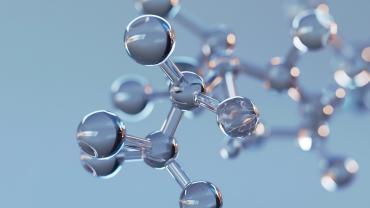
Peptides are growing in popularity among health and fitness individuals who are committed to staying proactive about their wellness and physical performance. Bioactive peptides have specific biological actions that positively affect living organisms. They primarily consist of fewer than 50 amino acids and are classified as endogenous or exogenous. Endogenous peptides are produced by various cell types within the body. For example, the pancreatic islet cells produce the peptide hormone insulin, and the intestinal L cells produce glucagon-like peptide-1 (GLP-1). Exogenous sources of bioactive peptides include foods, dietary supplements, and medications. Bioactive peptides may be applied broadly, including as cell adhesion molecules, structural peptides, cell-penetrating peptides, antimicrobial peptides, peptide hormones, growth factors, neuropeptides, amyloid peptides, and antioxidant peptides.
Amino Acids, Peptides, and Proteins
The appeal of peptides comes from enhanced bioavailability and less allergenicity compared to proteins due to their smaller structure. Proteins are large molecules made from different sequences of 20 standard amino acids. These amino acids can be combined in countless ways — one of the largest known proteins, for example, is made up of about 35,000 amino acid sequences. Amino acids are considered the “building blocks for proteins” because when protein is consumed at a meal, the body’s digestive system breaks proteins apart into peptides, and then finally into amino acids. The body can then use the free pool of available amino acids to build essential peptides. Like free-form amino acids, which can be consumed in supplemental form (e.g., lysine, glutamine, taurine), bioactive peptides are available in a pre-formed, bioavailable state for potential clinical benefits.
Bioactive Peptides in Action: Examples of Important Peptides
Compared to proteins, which can consist of as many as 35,000 amino acid sequences, bioactive peptides have a chemical structure comprised of two to 50 amino acid sequences. For example, glutathione is an antioxidant that the body uses to promote a healthy inflammatory response and is made from three amino acids (tripeptide) – glycine, glutamate, and cysteine. Additionally, several peptides between five and 16 amino acids support antioxidant status. Oxytocin, a neuropeptide, is often called the “love hormone” because it is secreted when humans experience intense love and bonding, such as when a mother holds her newborn baby. Oxytocin is composed of nine amino acids. Insulin supports normal glucose metabolism. Although insulin is made up of 51 amino acids, it is still considered a peptide (versus a polypeptide, which is a larger molecule). Finally, glucagon is a peptide hormone secreted by the alpha cells of the pancreas. It stimulates glucose production in the liver by promoting glycogen breakdown and gluconeogenesis, which supports blood sugar regulation. Glucagon is made up of 29 amino acids.
Emerging Clinical Research on Bioactive Peptides
Research investigating the role that bioactive peptides play in human health is advancing rapidly, with significant focus on metabolic health, muscular endurance and recovery, and skin health. Research into muscular recovery investigated how one group of bioactive peptides, called PeptiStrong™, has been shown to act on certain pathways in the body that stimulate muscle protein synthesis. In a randomized, double-blind, placebo-controlled, parallel-group trial, 30 healthy males (30 to 45 years old) were recruited to receive either a placebo (silicified microcrystalline cellulose; SMCC) or PeptiStrong™ supplementation with the first meal of the day for 17 days. The primary outcome being investigated was the effects of PeptiStrong™ supplementation on muscle strength and recovery after exhaustive, damaging exercise, which induced delayed onset muscle soreness (DOMS). After daily supplementation with 2.4 g of either placebo or PeptiStrong™, the group that was given the PeptiStrong™ supplementation exhibited significant strength recovery after exhaustive exercise (P = 0.025) compared to their baseline strength. Compared to the placebo group, the group given PeptiStrong™ exhibited a significant improvement in strength recovery (P = 0.027) and muscle fatigue (P = 0.041) 72 hours post-DOMS. PeptiStrong™ may help increase muscle recovery rate by 144%, athletic performance recovery by 54%, and help reduce muscular fatigue by 47%, which may further support muscular endurance in active individuals.
Apart from studies focusing on muscular strength and recovery, S-Pea oligopeptide-1 SP (commercially known as PeptiYouth™) is a recently discovered peptide that helps improve markers of aging skin. As the body ages, changes to skin health become apparent, including fine lines, wrinkles, and changes to pore quality and skin texture. Additionally, aging skin experiences reduced protein synthesis, which affects elastin and collagen formation. In a randomized, double‑blind, split‑face pilot study, 94 healthy female volunteers applied either an emulsion containing PeptiYouth™ at varying concentrations (e.g., 10, 25, or 35 ppm) or a placebo emulsion without PeptiYouth™ to either half of their face, twice daily, for 28 days. Compared to the baseline, the application of the peptide solution at 35 ppm showed a 9% reduction in maximum wrinkle depth and a 3% increase in collagen density, indicating an improvement in wrinkles. These results were verified upon visual assessment by the researchers.
In summary, recent clinical studies demonstrate that bioactive peptides, such as PeptiStrong™ and PeptiYouth™, can support muscle recovery after intense exercise, as well as help improve markers of aging skin. These studies highlight bioactive peptides’ potential to support health broadly across various clinical applications.
Limitations and Conclusion
As research investigating bioactive peptides’ efficacy in human health continues to unfold, their expanding role in muscle recovery and endurance, as well as skin rejuvenation, highlights their exciting potential. However, it’s essential to recognize that while early clinical study results are promising, bioactive peptides are relatively new to the research landscape, which comes with limitations. Their rapid metabolism and elimination mean that sustained effects may require consistent intake. Additionally, their efficacy can vary depending on peptide source, structure, and individual absorption rates. More large-scale, long-term human trials are needed to fully understand safety profiles and benefits across diverse populations.
To learn more about peptides:
Decoding Peptides: The Body’s Little Helpers
Collagen Peptides to Promote Skeletal Muscle
Revitalize and Rejuvenate: Harnessing Collagen Peptides for Recovery After Aesthetic Treatments
Bioactive Peptides From the Fava Bean: The Future of Muscular Health?
By Bri Mesenbring, MS, CNS, LDN